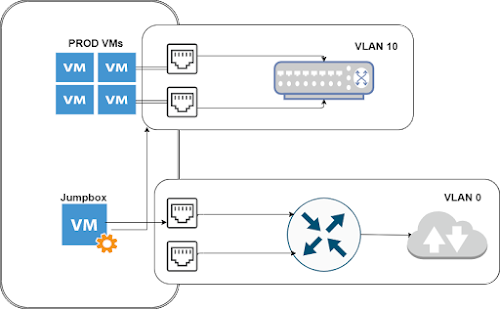Some notes from a recent lab I configured:
My current lab looks like this -
- I have few production VMs in one VLAN segment
- External network access and Internet access is through another VLAN segment
- There is a jumpbox VM that is uplinked to both the VLAN segments.
- VMware vDS is currently being used and there are no free uplinks to make use of nvds.

What do I want to accomplish?
I want to NAT between vlan10 and vlan 0 using a nsx-t t0 edge.

So, lets see how we can accomplish this is in nsx-t
- After deploying NSX-T, begin by adding a compute manager in NSX-T.
System->Fabric->Compute Managers->Add - Create an overlay transport zone.
System->Fabric->Transport Zone->Add - Create an uplink profile for the overlay.
System->Fabric->Profiles->Uplink Profiles->Add
Ensure you specify the transport vlan that the overlay vteps should use here. - Create a Transport Node Profile so we don’t have to configure each esxi host.
System->Fabric->Profiles->Transport Node Profiles->Add
You can choose to deploy a new N-VDS if you have free uplinks. I chose VDS.
Choose the transport zone you created in Step 2 and the uplink profile in step 3.
Also, choose how the vteps should get an ip address. You will need to create a static ip pool or use dhcp. Map the uplinks that the vteps should use for overlay traffic - Configure NSX on the esxi hosts. System->Fabric->Nodes->Host Transport Nodes-> choose the cluster->configure NSX->Select the Transport Node profile you created in step 4.
- Create an uplink profile for the edge VM.
System->Fabric->Profiles->Uplink Profiles->Add - Create an Edge Cluster
System->Fabric->Nodes->Edge Clusters->Add - Deploy an Edge VM
System->Fabric->Nodes->Edge transport Nodes->Add Edge VM
Choose the overlay transport zone and the uplink profile created in step 6. Map the uplinks to relevant portgroups on your VDS. - After the node status for the edge says “Up”, lets create a vlan transport zone for the logical segments We will use this vlan transport zone to map VLAN 10 and VLAN 0 in the next step.
System->Fabric->Transport Zone->Add->Select VLAN - Create two vlan segments. one for vlan 10 and the other for vlan 0
Networking->Segments->Add Segment.
Just select the vlan transport zone and specify the vlan number - Depoy a t0 router.
Networking->Tier-0 Gateways->Add Gateway
Select the edge cluster that we created in step 7. - After the gateway is deployed, add both the interfaces.
Networking->Tier-0 Gateways->edit the t0 router you deployed in Step 11->Interfaces->External and Service Interface->Add Interface
- For vlan 0, choose Type as external, specify ip address and select the segment created in step 10
- For vlan 10, choose Type as service, specify ip address and select the other segment created in step 10
- Now we will need to configure routing on the t0.
Networking->Tier-0 Gateways->edit the t0 router you deployed in Step 11->Routing->Static Routes I just specified a route of 0.0.0.0/0 to the gateway on the vlan 0 subnet. - The last thing to do is to create the SNAT rule. Networking->Network Services->NAT->Add NAT rule. Specify the source subnet and the translated IP. Now all the clients in VLAN 10 will be able to reach clients in VLAN 0